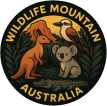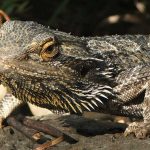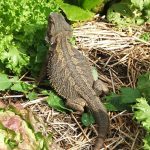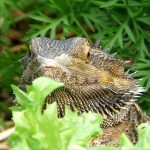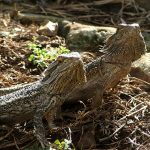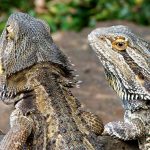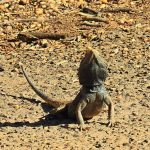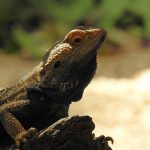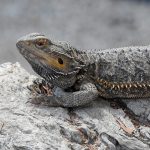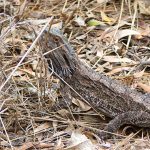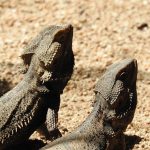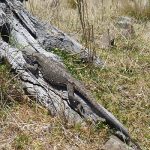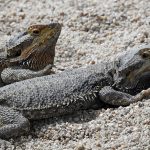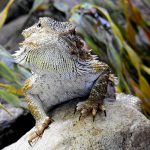EASTERN BEARDED DRAGON
An Icon of Australian Wildlife
With its striking appearance and fascinating behaviours, the Eastern Bearded Dragon is one of Australia’s most recognised reptiles.
Vivid Appearance and Adaptations
The Eastern Bearded Dragon is instantly recognisable:
- Size: Grows up to 60 centimetres in length, including its tail.
- Scales and ‘Beard’: Covered in rough, spiky scales; its expandable throat pouch, or
beard, turns a deep black when threatened or excited, creating a dramatic display. - Camouflage: Colours ranging from grey and brown to black allow it to blend with rocky outcrops or fallen logs, offering effective camouflage in its varied habitats.
Sensory Description
You might spot a bearded dragon motionless on a sun-warmed stone, its scales glinting in the light and its ‘beard’ puffed, a majestic silhouette against the dry earth. The air nearby may carry the faint scent of eucalyptus, mingling with the warmth radiating from the sun-baked ground.
Masters of Thermoregulation
Like all reptiles, Eastern Bearded Dragons are ectothermic:
- Basking: Often seen resting in sunlight in the morning, absorbing warmth on stones, tree branches, or even fences.
- Seeking Shade: During the hottest parts of the day, they retreat to cooler, shaded areas to avoid overheating.
- Climbing Ability: Their sharp claws and strong limbs allow them to scale trees and other high perches, giving them both a vantage point and more options for managing their temperature.
Intriguing Behaviours
Body Language
Eastern Bearded Dragons have mastered non-verbal communication:
- Beard Puffing: Used to warn off predators or rivals.
- Head Bobbing: Fast bobs signal dominance, while slower, deliberate bobs can be a courtship gesture.
- Arm Waving: Rotating a front leg, often interpreted as a sign of submission or recognition.
The Remarkable Third Eye
- Parietal Eye: Located on the top of the dragon’s head, this small, light-sensitive structure isn’t used for normal vision. Instead, it helps detect changes in light, such as the shadow of a flying predator overhead, and aids in regulating daily activity cycles.
Omnivorous Diet
Eastern Bearded Dragons are opportunistic feeders:
| Animal Diet | Plant Diet |
|---|---|
| Crickets | Flowers |
| Beetles | Fruits |
| Grasshoppers | Leafy greens |
| Ants | Occasionally seeds |
This varied diet not only ensures survival through seasonal food changes but also supports their robust health.
Life Cycle and Breeding
- Breeding Season: Primarily during the warmer months.
- Courtship: Males perform elaborate head bobs and display their darkened beards.
- Eggs: Females lay clutches of eggs — typically in sandy or soft soil, well-hidden from predators.
- Incubation: Offspring emerge after about two months, ready to fend for themselves.
Longevity
In their natural setting, Eastern Bearded Dragons can live up to 10 years.
Habitat and Range
- Distribution: Spans eastern Australia, from Queensland, through New South Wales, to Victoria.
- Habitats: Woodlands, scrublands, heath, and even urban gardens and parks.
Conservation and Threats
Although classified as Least Concern, Eastern Bearded Dragons face ongoing challenges:
- Habitat Loss: Land clearing for agriculture and urban expansion reduces available shelter and food sources.
- Invasive Predators: Domestic pets (dogs and cats) and introduced species like the fox are significant threats.
- Illegal Pet Trade: Collection from the wild still occurs, despite legal protections.
Subtle Conservation Reminder
Understanding the delicate balance of their habitats reminds us how each species plays a role in maintaining ecosystem health. By supporting efforts that protect natural environments and discouraging illegal wildlife trade, we can help ensure the Eastern Bearded Dragon thrives for generations.
Inspiring Connection
The Eastern Bearded Dragon embodies adaptability and resilience in the ever-changing Australian landscape. Its presence, from sunlit woodlands to suburban backyards, is a gentle reminder of nature’s complexity and the value of vigilant stewardship.
Fascinating Facts
- Colour Change: Along with puffing their beard, these dragons can change skin colour slightly, often becoming darker to better absorb heat.
- Social Creatures: While solitary by nature, they can be seen basking in loose groups in ideal spots.
- Tail Use: Their strong, muscular tail aids in balance and can be wielded as a defensive tool if threatened.
- Unique Footprints: Eastern Bearded Dragons leave distinctive, splayed footprints in sandy soil, with a tail drag line down the centre.
By learning about and valuing remarkable creatures like the Eastern Bearded Dragon, we take the first steps toward safeguarding the extraordinary biodiversity that makes Australia unique.
